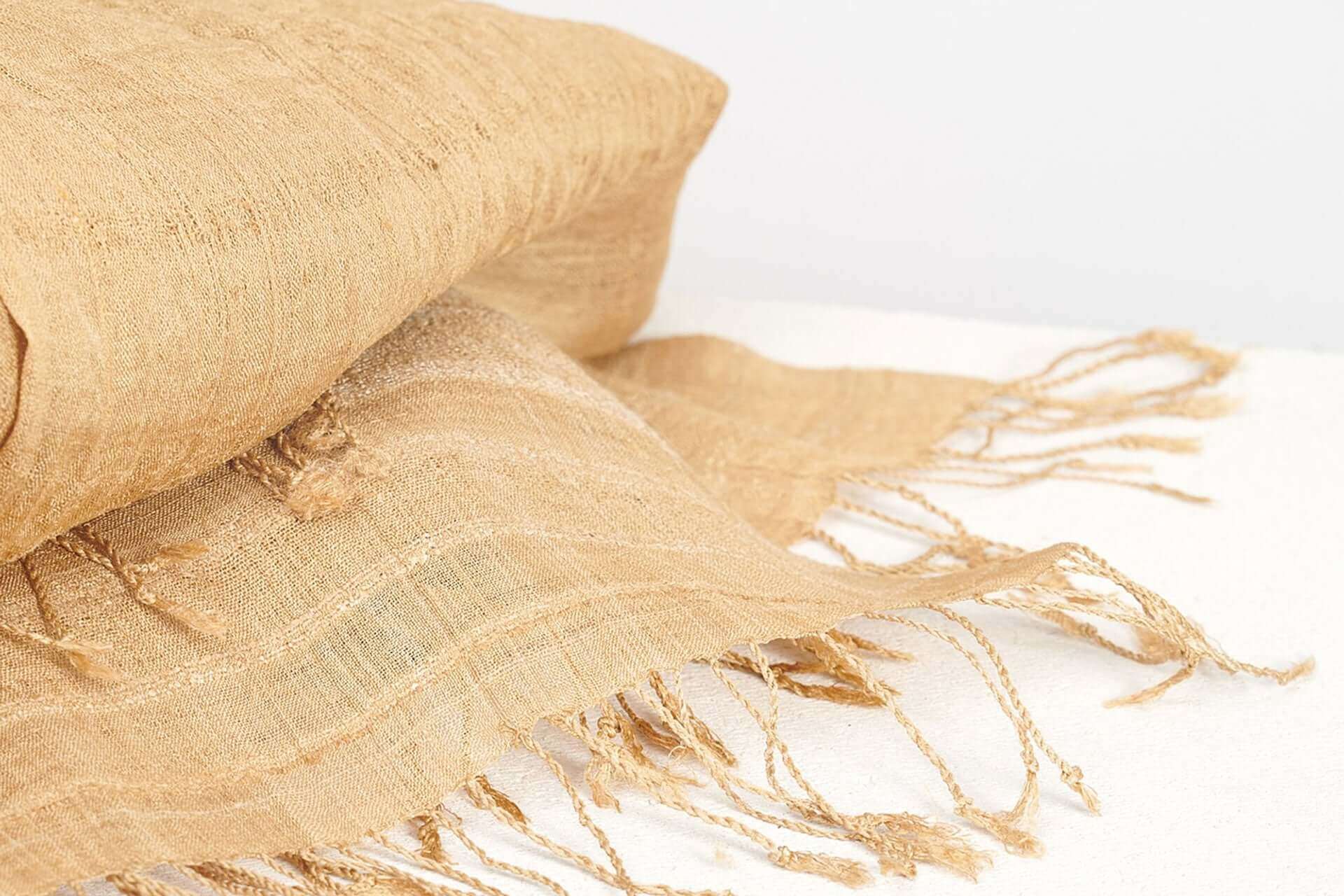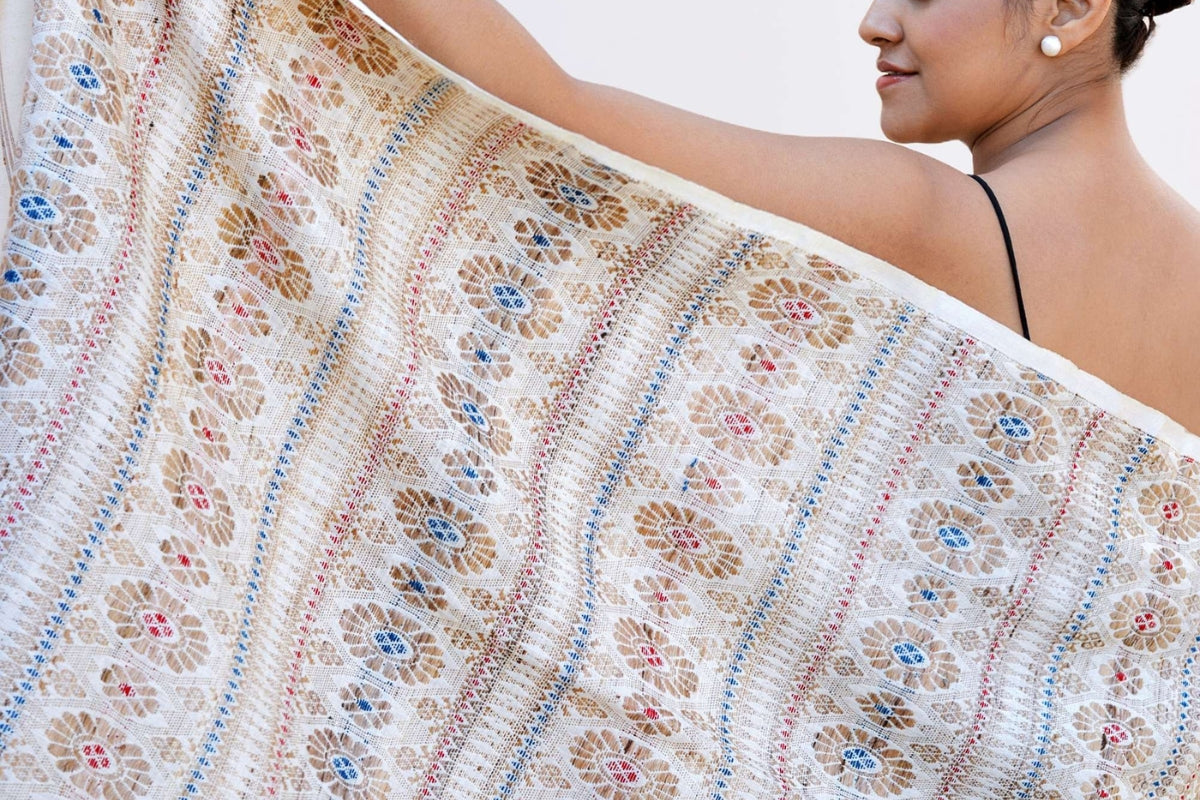The royalty that Muga silk holds, makes it one of the finest textiles in the world. But even amongst silks, Muga is easily one of the most exotic ones. Formerly reserved only for royalty. Muga is a crucial component of many East Indian nations’ traditional attire because of its unrivalled durability and natural fibre with a brilliant golden lustre. It’s expensive and valuable due to the scarcity of the silk worms that produce it and the diminishing number of trees that these worms call home. However, as we shall see in the coming paragraphs, rarity is not the only reason why this silk is valuable today. It has unique chemical and physical properties that renders it as one of the most prized textiles in the world.

Muga Silk: The Pride Of Assam
Muga silk is produced exclusively in the north-eastern state of Assam in India. Since 2007, it has been designated as a Geographical Indication (GI) for the state. The word ‘Muga’ in Assamese means ‘yellowish’ as this silk has a distinguished golden-yellow hue. This silk is elemental in Assamese cultural and aesthetic traditions. It is, in fact, so central to Assamese culture that there are even traditional songs and dances around it. The Muga silk tradition in Assam reached its zenith during the Ahom Dynasty, which ruled the region for nearly 600 years. Muga culture flourished throughout this time period. Ahom rulers were renowned for wearing Muga silk exclusively, and it was also gifted to special court guests.

A Brief History About Muga
Muga silk is derived from the Muga silkworm, which dates back to the dinosaur era and is so delicate in nature that it cannot withstand even the minimum levels of pollution. This silk is made from the semi-cultivated silkworm “Antheraea assamensis.” It is organic and natural, as well as the strongest natural fibre known to man. These silkworms feed on the leaves of two plants, namely: Som and Soalu, that are distributed throughout Northeast India and which grow up to an altitude of 1,500 feet above the sea level.

Benefits of Muga
The most beneficial quality of Muga is that it blocks ultraviolet (UV) rays. Hence, it offers protection to the skin from the harmful effects of UV rays. Exposure to the sun is known to be associated with different types of skin cancer, accelerated skin ageing, cataract and other eye diseases. There is also evidence that UV radiation reduces the effectiveness of the immune system. The micro-structure of the textile absorbs 85 percent of harmful ultraviolet rays from the light that it is exposed to. This UV ray absorbing property makes it one of the most unique silks in the world. Being highly non-reactive, this silk is not only friendly for even hypoallergenic skin types, but it also offers protection from harmful UV rays.
The Longest Lasting Silk
The most promising characteristics of the Muga silk are its durability and its protective structure. This textile has a lifespan of up to 100 years. With high material strength in all directions, Muga silk is almost impossible to rip. It also is not highly absorbent of moisture or reactive with environmental agents. Technically, though its lifespan is marked at 100 years, with proper care, a Muga outfit can easily be passed on between multiple generations. In most cases, a Muga Silk fabric is said to outlive its wearer.
Proteins That Are Skin-Friendly
A Muga silk fibre is 97% protein, 3% fat, and 3% wax, and it contains 18 amino acids that are good for the skin. Muga silk is the most allergy-free fabric available. It repels dust mites and is resistant to dust, fungus, mould and a few other pollutants. It is well-known for its tenacity. Muga silk fibres are similar to human hair. It aids in reducing skin moisture loss and thus stimulates skin regeneration, as well as delaying the signs of ageing. It alleviates dry, flaky skin problems by trapping moisture in and ensuring it remains on your skin.
Care
In terms of use, Muga Silk textiles should be hand washed gently in cold water with a mild detergent. It can be finely textured by damp dry ironing or crushed by not being ironed. This one-of-a-kind fabric has a golden lustre that improves with age. Often popular in the United States, South Africa, and the Middle East, Muga Silk’s next stop is Japan, where designers use it to make kimonos and other traditional Japanese dresses. Muga silk fabric has a very smooth surface, is extremely soft to the touch, and is highly lustrous. In fact, among all fabrics, Muga silk is the least allergenic of all fabrics. One of the most distinguishing characteristics of Muga silk is that the fabric’s sheen is supposed to enhance with each wash.

Muga: a Ray of Sustainability
But besides the rarity of the Muga silk, it is the sustainability of the entire value chain behind its production and consumption that makes it distinguishable. Unlike many eco-products that focus solely on environmental sustainability, Muga also excels in the socio-cultural aspect of sustainability. Women in rural Assam play an important role in the weaving of the textile and rearing of the silkworms. Muga not only provides livelihood to the communities involved in its production, but it also adds to the richness of the Assamese culture, of which it is an integral part. Assamese families have traditionally used Muga to make the two piece attire for women called Mekhela-Sadar. It is worn by women on very special occasions and during Bihu, the main festival of the state.
But the most important sustainability feature of Muga is its physical and emotional durability. It is the best example of slow fashion. You can never outwear it. And you can never outgrow its beauty and comfort. You will love it till you have it.
Process of Production
Producing Muga silk is not just a labor intensive process but also requires great skill of hand. If we go through the entire making process, it begins with the workers unwinding a Muga silkworm’s cocoon into a single seamless spread. Approximately 1000 cocoons must be unrivalled for about 1 meter of the textile. The majority of Muga Silk cultivation takes place in Assam’s West Garo hills, with a small amount taking place in West Khasi hills, which are the only habitats for the Som and Soalu trees. A silk farmer in the Garo hill area typically needs at least one acre of land to grow 400 gms of Muga silk at a time. However, a bigger challenge for the Muga Silk industry is the current fragility of the value chain. The Muga silkworm is an endangered species today. Climate change and the dwindling Som and Soalu plantations have together contributed towards the survival threat of these silkworms.

Dzukou’s Muga scarf is 100 percent organic and hand-woven without the use of electricity. Wouldn’t it be fantastic if we could make all the clothing without using any energy? We’re doing everything we can to change the way people dress, one scarf at a time. These scarves were created with love and respect for those who will wear it as well as those who will weave it.

Read more at Dwima Collective





